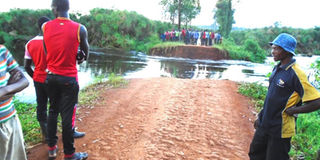Floods cut off Kayunga from Mukono District

Left without means. Residents stranded after the bridge was washed away by floods on Saturday. PHOTO BY FRED MUZAALE
What you need to know:
Effect. The havoc on the bridge has left many people dealing in perishable produce struggling to deliver them to the market.
The ongoing torrential rains that have washed away a bridge on a major road that links Kayunga District to Mukono District, leaving residents stranded.
The submerged bridge is found on River Ssezibwa, which lies between Kasawo and Ntunda sub-counties on the Kyabazaala-Kabimbiri road.
The road provides a shorter access root to Ntunda sub-county, which is the major fruit and banana growing area in the country. Traders from Kampala, Mukono and Kayunga take only 30 minutes to connect to Mukono Town using the same route.
But currently, traders have to use Ntunda–Kyabazaala–Kayunga Road to Mukono, which is one-and-a-half hour drive.
Some traders told Daily Monitor that they have spent three days stranded with produce such as maize and other perishables, including tomatoes, onions, matooke, Irish potatoes, and cabbage.
“Fixing the bridge may take long and despite remaining with less fuel, I have to risk and take a longer route to connect to Mukono,” Mr Sulaiman Ssekindi, a transporter, said.
The damaged road was built by Uganda National Roads Authority (Unra) and commissioned by President Museveni four years ago.
Challenge
The Ntunda Sub-county chairperson, Mr Philly Ssenzira, said students from Kasawo sub-county, who study from schools in Ntunda such as BLK Muwonge Senior Secondary School, Central Standard Secondary School, Kyabazaala Public Primary School, and others cannot access them.
“When the bridge was washed away on Friday, the schools hired vehicles to transport learners to their homes via Kayunga Town,” Mr Ssenzira said.
He noted that canoes cannot be used to cross the road since the water moves very fast.
Mr Ssenzira said although no lives have been lost, residents are at risk.
The Mukono District chairperson, Mr Andrew Ssenyonga, blamed the problem on shoddy work and appealed to government to repair the bridge immediately to enable residents take their agricultural produce to the market.
“As a district, we don’t have the capacity to repair such a bridge, it is only government that can rescue us,” he said.
On a similar note, River Ssezibwa has also bust its banks in Buikwe District, rendering many feeder roads in the area impassable.
Uganda has two major rain seasons (March to May) and (September to December), but due to climate change, the onset of rain sometimes becomes destructive.
Meteorologists warn
On Saturday, the Uganda National Meteorological Authority (UNMA) issued a heavy rainfall warning alert over most parts of Uganda between October 26 to October 30.
“Please take note that Tuesday 29 and Wednesday 30 October are expected to have more rainfall within this forecast period,” a statement signed by Mr Paul Isabirye, the acting executive director, read in part.
“These rains are expected to bring about flooding, especially in the urban areas and low lying areas, mudslides in the mountainous areas and lightning coupled with strong winds,” the statement added.
Mr Isabirye advised the public to avoid taking shelter under trees during rainfall to minimise exposure to lightning strikes.




